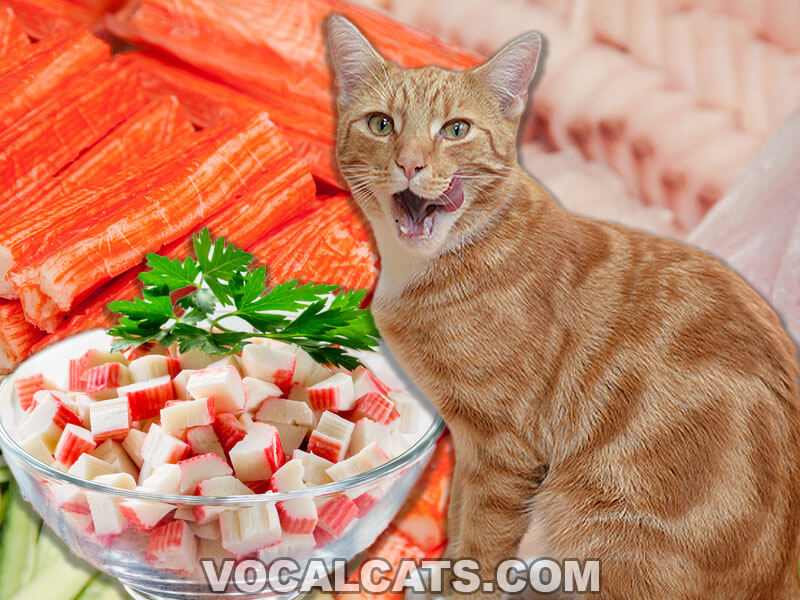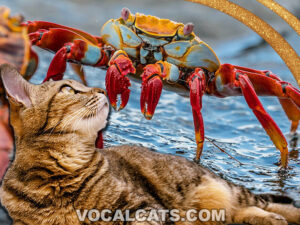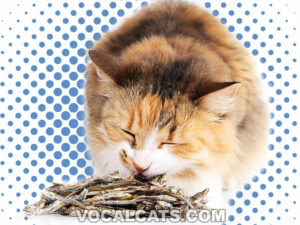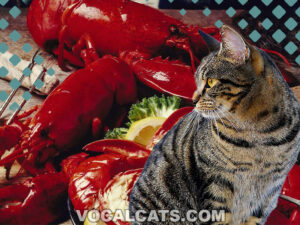Can Cats Eat Imitation Crab? Yes, cats can eat small amounts of Imitation Crab as an occasional treat. However, it should not be a regular part of their diet due to its high sodium content and artificial additives. Feeding your cat Imitation Crab regularly could lead to health issues. You’ll want to monitor your feline friends for adverse reactions when introducing new foods like Imitation Crab.
Imagine this: you’re in the kitchen, preparing a delicious Crab salad, when suddenly, your curious cat leaps onto the counter, meowing and giving you that irresistible look. As a loving cat owner, you’re tempted to share some of it with your feline friend, but you suddenly wonder, “Can I feed my cat Imitation Crab?”
Imitation Crab is a delicious treat for humans, but can our feline friends also indulge in this seafood treat? In this article, we will explore whether it’s safe to share Crab Sticks with your furry friends and discuss the potential benefits and health risks associated with feeding them this food.
Contents
- Can Cats have Imitation Crab?
- Is Imitation Crab bad for cats?
- Is Imitation Crab good for cats?
- Is Imitation Crab safe for cats?
- Is Imitation Crab okay for cats?
- What to do if my cat Eats Imitation Crab?
- How to properly feed your Cat Imitation Crab
- Safe and feline-friendly alternative to Imitation Crab for cats
- So, Can Cats Eat Imitation Crab?
- Related Questions
Can Cats have Imitation Crab?
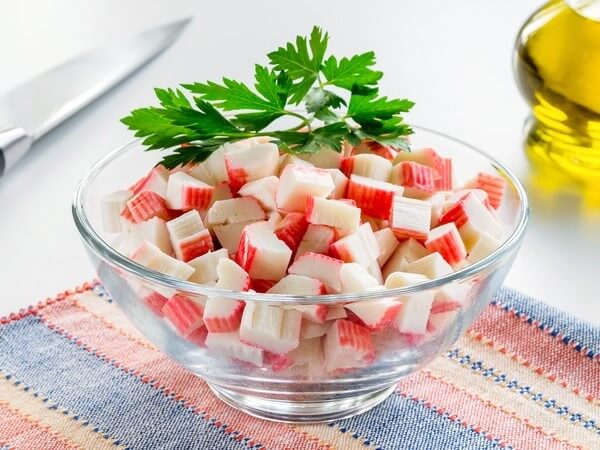
Yes, cats can have Imitation Crab, but it’s essential to understand that Crab Sticks should only be given to cats in small amounts and as an occasional treat.
Imitation Crab Sticks should not be a regular part of their diet, and we’ll discuss why in the sections below.
RELATED: Can Cats Eat Sardines? (Canned, Raw, Dried, Oil)
What is Imitation Crab?
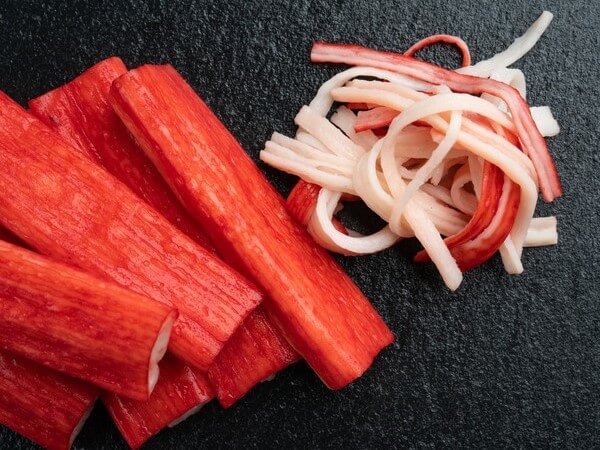
Imitation Crab goes by several names. You may have heard of Crab sticks, fake Crab, seafood sticks, or artificial Crab.
So what is it?
It is exactly what it sounds like. Imitation Crab or seafood that is made to look, taste, and feel like the leg meat of a snow Crab or real Crab meat.
This seafood delight is generally made from a mixture of finely ground white fish, such as pollock, hake, or whiting, combined with other ingredients like starches, salt, egg whites, sugar, and flavorings.
The mixture is then formed into the desired shape, such as sticks or flakes, and colored with natural or artificial colorants to achieve the characteristic red-orange hue of cooked Crab.
Many restaurants opt for Imitation Crab instead of real Crab meat because it is more affordable.
You can use this Crab alternative in various popular dishes, including sushi rolls, Crab or seafood salads, and pasta dishes.
As we’ll learn later, while this Crab substitute has a similar texture and taste to real Crab, it is generally lower in nutritional value and may contain artificial additives and preservatives.
So, let’s go ahead and take a closer look at the ingredients in Imitation Crab to understand why moderation is key when offering your fuzzy friends Imitation Crab.
RECOMMENDED: Can Cats Eat Lobster? Read This Before Offering a Bite
What is Imitation Crab made of?

As we can see, Imitation Crab does not contain any Crab. Instead, Imitation Crab is highly processed and primarily made from finely ground white fish, like Alaskan pollock or hake.
Here are the ingredients in the Crab Sticks:
Imitation Crab ingredients
- Fish protein (usually white fish like pollock, hake, or whiting)
- Water
- Wheat starch or other binding agents (e.g., potato starch or tapioca)
- Egg whites
- Sugar or other sweeteners
- Salt
- Artificial or natural crab flavoring
- Colorants, like paprika extract or carmine, to achieve the red-orange hue similar to cooked Crab
- Soybean oil or other vegetable oils
- Sodium tripolyphosphate or other additives to help retain moisture and improve texture
- Other preservatives, like potassium sorbate or sodium benzoate, to extend shelf life
So, why use pollock or hake instead of other types of fish? There are several reasons for this:
- Mild flavor: Pollock and hake have a mild and delicate flavor that works well as a base for Imitation Crab. Their subtle taste allows the addition of other flavors and seasonings to create a product that closely resembles the taste of real Crab.
- Firm texture: The firm, white flesh of pollock and hake is suitable for creating the desired texture in Imitation Crab. The fish meat can be easily ground and processed into a smooth paste (surimi), which can then be shaped and cooked to mimic Crab meat’s flaky yet firm texture.
- Abundance and affordability: Pollock and hake are relatively abundant fish species, which makes them more cost-effective for large-scale production. Using these types of fish as the primary ingredient can help keep the price of Imitation Crab lower than real Crab, making it an affordable alternative for consumers.
- Sustainability: Both pollock and hake are considered sustainable seafood options, as their populations are well-managed and their fishing practices have less environmental impact than other fish species. This makes them a more responsible choice for producing Imitation Crab.
- Availability: Pollock and hake are widely available in many parts of the world, which makes them easily accessible for large-scale surimi production. Their year-round availability ensures a steady supply for Imitation Crab manufacturers.
READ ALSO: Can Cats Eat Anchovies? (Dried, Canned, Raw & Oil)
This faux Crab is essentially made with surimi. So what is surimi?
Surimi is a processed seafood product primarily used as the base ingredient for creating Imitation Crab and other similar food. The process of making surimi involves several steps, which we’ve outlined below:
Selecting the right fish
The first step in the surimi-making process is selecting a suitable fish species. White fish like pollock, hake, or whiting are common choices, known for their mild flavor and firm texture (as discussed above).
Deboning and mincing the fish
The fish is then deboned, and the flesh is minced into a fine paste. This process helps to create a uniform texture for the surimi.
Washing and refining
The minced fish paste is then washed several times with cool water to remove any impurities, blood, and unwanted fishy flavors. This step ensures that the Imitation Crab is clean-tasting.
Cryoprotectant addition
Cryoprotectants like sugar or sorbitol are added to the fish paste to prevent protein degradation during freezing. These substances help maintain the texture and quality of the surimi during storage.
Mixing
The fish paste is mixed with other ingredients, such as starches, egg whites, vegetable oil, and flavorings, to create the desired taste and texture. The mixture is then kneaded and blended to ensure a consistent product.
Forming and shaping
Depending on the final product’s intended use, the surimi mixture is formed into various shapes, such as sticks, flakes, or chunks. This shaping process may involve extrusion, molding, or cutting the mixture into the desired form.
Coloring
To achieve the characteristic red-orange color of cooked Crab meat, the surimi is colored using natural or artificial colorants like carmine or paprika extract. This step is crucial for Imitation Crab products.
Cooking
The shaped surimi is cooked by steaming or boiling to set the texture and enhance the flavor. Cooking also helps to maintain the product’s shape and form.
Cooling and packaging
Once cooked, the surimi is cooled and packaged to preserve its freshness and quality. Vacuum sealing or modified atmosphere packaging techniques are commonly used to extend the product’s shelf life.
Freezing and storage
Finally, the surimi is frozen and stored at low temperatures to maintain its quality until it reaches consumers. Proper freezing and storage are essential to prevent spoilage and ensure the surimi remains safe to eat.
Is Imitation Crab bad for cats?
While Imitation Crab can be offered as an occasional treat, it’s essential to understand that it’s not the healthiest choice for your feline friend.
Here are ten reasons why Imitation Crab is bad for cats:
1. High sodium content in Imitation Crab can lead to sodium poisoning in Cats
Imitation Crab has a high sodium content. On average, a single Imitation Crab stick (approximately 30 grams) contains around 200 to 300 milligrams of sodium.
While that may not seem like a lot of sodium to us, this is considered a lot for our little furry friends.
Therefore, it is essential to check the nutritional label on the packaging to find the exact amount of sodium in your Imitation Crab, as some brands may have higher or lower sodium levels depending on the specific recipe used.
Remember that the daily recommended sodium intake for cats depends on their size, age, and activity level. Generally, adult cats only need between 21 and 42 milligrams of sodium per 100 calories of food consumed or 200 milligrams of sodium per kilogram of body weight each day.
To find out your feline friend’s specific dietary need, we recommend you consult your veterinarian for personalized advice.
If your cat consumes more sodium than his body can handle, he may experience hypernatremia or sodium poisoning.
There is also an imbalance of electrolytes in the body, which can adversely affect various body functions, including muscle and nerve functions, and cause dehydration.
Some of the signs and symptoms of sodium poisoning in cats may include the following:
- Excessive thirst (polydipsia): Your fuzzy friend will drink more water to try to balance the increased sodium levels in his body.
- Increased urination (polyuria): As a result of drinking more water, your kitty will also urinate more frequently.
- Lethargy: Your kitty may become weak and less active due to electrolyte imbalances.
- Loss of appetite: Your cat no longer wants to eat.
- Vomiting: It is a way to eliminate excess sodium from the body.
- Diarrhea (loose or watery stools).
- Muscle tremors or seizures: High sodium levels can interfere with muscle and nerve function, leading to tremors or seizures.
- Swelling or edema: Excess sodium can cause fluid retention, resulting in swelling of the limbs or other body parts.
- Difficulty breathing: Your cat may show signs of respiratory distress, such as labored or rapid breathing, as fluid accumulates around the lungs.
- Coma or death: In severe cases of sodium poisoning, cats may become unresponsive or even die if left untreated.
If you suspect your feline companion is experiencing sodium poisoning, it is crucial to contact your veterinarian right away for professional advice and treatment.
As we can see, feeding your cat Imitation Crab regularly is not a good idea. The long-term effects of doing so include high blood pressure and kidney issues in cats.
2. Artificial flavoring in Imitation Crab can cause gastrointestinal upset in cats
Do you know the secret behind the delicious flavor of Imitation Crab and what makes it taste so similar to real Crab?
Well, the secret is this: using artificial flavorings.
Some of the artificial flavorings in Imitation Crab include Monosodium Glutamate (MSG), Disodium Inosinate, Disodium Guanylate, artificial crab flavor, and maltodextrin.
While these additives help to enhance the taste and texture of Imitation Crab, they are not healthy for our furry friends.
Let’s go over each of the artificial flavorings listed above to see how they can affect our cat’s health:
- Monosodium Glutamate (MSG): While small amounts of MSG are not harmful, excessive consumption could lead to gastrointestinal upset or neurological symptoms.
- Disodium Inosinate and Disodium Guanylate: Cats that consume food with these flavorings can get soreness and burning sensation around the mouth, chest tightness, and difficulty breathing. Like MSG, excessive amounts may cause gastrointestinal upset or other health issues.
- Artificial Crab Flavor: While some artificial flavorings may be harmless, others could cause adverse reactions in sensitive cats.
- Maltodextrin: This carbohydrate is often used as a carrier for artificial flavors. Cats that consume a lot of this can get an upset stomach.
It’s important to note that our four-legged friends have different dietary needs and sensitivities than humans, and their tolerance to artificial flavorings may vary.
Feeding your cat a diet specifically formulated for their needs is the best way to ensure they receive the proper nutrition without potential risks from artificial flavorings.
3. Preservatives in Imitation Crab can cause upset stomach in cats
Both potassium sorbate and sodium benzoate are preservatives used to extend the shelf life and hinder the growth of mold, yeast, and bacteria in Imitation Crab.
But how do these two types of preservatives affect our feline friends?
While small amounts of sodium benzoate and potassium sorbate might not harm cats, excessive consumption or long-term exposure could lead to adverse effects.
As we know, cats have unique dietary needs and sensitivities compared to humans, and their tolerance to preservatives and additives may vary.
Regarding sodium benzoate, ingesting large amounts of this preservative may cause gastrointestinal upset in cats, leading to vomiting, diarrhea, and loss of appetite.
Additionally, high sodium intake can contribute to an electrolyte imbalance, which may negatively affect various bodily functions and be particularly harmful to cats with kidney or heart problems.
Like sodium benzoate, excessive consumption of potassium sorbate can lead to gastrointestinal issues.
This is why it is essential to be cautious with processed foods and additives that are not specifically formulated for feline consumption.
Suppose you have concerns about the potential effects of potassium sorbate, sodium benzoate, or any other additives in your cat’s diet. In that case, we recommend consulting your veterinarian for personalized advice and guidance.
Feeding your furry friend a diet specifically formulated for their needs can help ensure they receive proper nutrition without potential risks from additives found in human food.
4. Carmine or paprika extract used to achieve the red-orange hue color in Imitation Crab can cause irritation and allergic reactions in some cats
As we know, the main ingredient in Imitation Crab is surimi, which is a processed fish paste that was made from white fish like Alaskan pollock or Pacific whiting.
Many manufacturers will use colorants like paprika extract or carmine to achieve the same red-orange hue color and appearance as cooked Crab.
So what is carmine, and how does it affect our furry friends?
Carmine is another name for cochineal extract or natural red 4. It is a red dye derived from the dried bodies of the cochineal insect and is often used as a coloring agent in various food products, cosmetics, and textiles.
Cats have unique dietary needs and sensitivities compared to humans, and their tolerance to food additives and colorings may vary.
Although carmine is a natural dye, there is still the potential for it to cause an allergic reaction or sensitivity in some cats, leading to symptoms such as itching, skin irritation, vomiting, or diarrhea.
Similar to carmine, the paprika extract is also a natural coloring agent. It is derived from paprika, a spice made from ground sweet red pepper pods.
However, since it is not a natural ingredient in a feline’s diet, some cats may have varying levels of sensitivity to it.
Some cats may experience the following symptoms if they consume paprika extract or other types of colorants:
- Upset stomach.
- Irritation.
- Vomiting.
- Diarrhea.
- Changes in appetite.
5. Imitation Crab contains low nutritional value
Unless it is given as a rare occasional treat, there’s no other reason to feed our cats Imitation Crab meat.
That’s because Imitation Crab meat has a lower nutritional value than real Crab meat.
Here is a comparison of the nutritional values of Imitation Crab and real Crab meat.
Imitation Crab:
- Lower in protein: Imitation Crab has less protein than real Crab meat. A 3-ounce (85 grams) serving of Imitation Crab contains only 6 to 9 grams of protein.
- Higher in carbohydrates: Imitation Crab has more carbohydrates than real crab meat due to added starches and fillers. In just 3-ounce or 85 grams of Imitation Crab, there are around 10 to 15 grams of carbohydrates.
- Lower in vitamins and minerals: Imitation Crab generally contains fewer vitamins and minerals compared to real crab meat, especially essential nutrients like vitamin B12, zinc, and selenium.
- Lacks essential nutrients: Imitation Crab does not contain taurine, which cats need for proper health.
- Contains additives and preservatives: Imitation Crab may contain artificial flavorings, colorings, and preservatives, which may not suit cats with sensitivities or allergies.
Real Crab Meat:
- Higher in protein: Real Crab meat is an excellent source of lean protein, with around 16 to 20 grams of protein per 3-ounce or 85 grams serving.
- Lower in carbohydrates: Real Crab meat is low in carbohydrates, containing less than 1 gram per 3-ounce (85 grams) serving.
- Rich in vitamins and minerals: Real Crab meat is a good source of essential nutrients like vitamin B12, zinc, and selenium. It also contains smaller amounts of magnesium, phosphorus, and potassium.
- No additives or preservatives: Real Crab meat is a natural, unprocessed food without added artificial ingredients.
In summary, real Crab meat is generally more nutritious than Imitation Crab, as it contains more protein and fewer carbohydrates and is richer in essential vitamins and minerals.
6. Imitation Crab has a high carbohydrate content which can lead to feline obesity
Imitation Crab contains a relatively high amount of carbohydrates. In just a 3-ounce (85 grams) serving of Imitation Crab, there are 10 to 15 grams of carbs.
The high carbohydrate content in Imitation Crab is mainly due to the added starches and fillers used to create its texture and hold the product together.
High carbohydrate content in Imitation Crab can be bad for cats for the following reasons:
Cats are obligate carnivores
Cats have primarily evolved to consume animal-based protein and have a limited ability to process carbohydrates efficiently.
Their natural diet consists of a high protein, moderate fat, and low carbohydrate content.
Therefore, feeding your furry friends food that is high in carbohydrates can lead to an unbalanced diet and deprive them of essential nutrients found in animal-based protein sources.
Risk of obesity and diabetes
A diet high in carbohydrates can contribute to weight gain in cats, as they may not be able to metabolize the excess carbohydrates effectively.
Over time, obesity can put cats at risk of developing other health problems, such as the following:
- Diabetes.
- Inflammation.
- Osteoarthritis.
- Hypertension.
- Heart disease.
- Cancer.
- Urinary bladder stones.
Feline diabetes is often associated with a high-carbohydrate diet, and reducing carbohydrate intake can help manage or even prevent the onset of diabetes in some cases.
Gastrointestinal issues
Lastly, cats have a short gastrointestinal tract designed for digesting animal-based protein and fat efficiently, but not carbohydrates.
Feeding your fuzzy companion food that is high in carbohydrates, like Imitation Crab, may cause digestive issues such as the following:
- Vomiting.
- Diarrhea.
- Constipation (their digestive system struggles to break down and absorb carbohydrates properly.
7. Poor protein quality in Imitation Crab
The protein in Imitation Crab is not as easily digestible as real Crab meat or other high-quality protein sources for cats.
8. Some cats may have allergic reactions to some of the ingredients in Imitation Crab
Imitation Crab contains several ingredients that can cause allergies or sensitivities in cats.
Here are some potential allergens found in Imitation Crab and their explanations:
- Fish: The primary ingredient in Imitation Crab (usually Alaskan pollock or Pacific whiting) can be a potential allergen for some cats. Fish allergies in cats can manifest as itching, skin irritations, vomiting, diarrhea, or other gastrointestinal issues. While fish allergies are not as common, they can still occur in some cats.
- Wheat or other grains: Many Imitation Crab products contain wheat or other grains as a binder or filler to create the desired texture. Cats can develop allergies or sensitivities to these grains, leading to similar symptoms as fish allergies. Grain allergies in cats can be challenging to diagnose. Oftentimes, it requires an elimination diet under a veterinarian’s guidance.
- Egg whites: Some Imitation Crab products use egg whites as a binding agent. Although not as common, cats can develop an allergy to eggs. Symptoms of an egg allergy can include gastrointestinal issues, skin irritations, itching, and in rare cases, anaphylaxis.
Monitoring your cat closely for any adverse reactions when introducing new food items like Imitation Crab is crucial.
If you suspect your fuzzy companion has an allergy or sensitivity to any of the ingredients in Imitation Crab, we highly recommend that you consult your veterinarian for guidance and appropriate treatment.
9. Gluten content in Imitation Crab can be problematic for cats with gluten sensitivity or celiac disease
As mentioned above, wheat or other grains are commonly used as binders and fillers in Imitation Crab. This means that Imitation Crab often contains gluten.
The gluten content in Imitation Crab comes primarily from wheat starch, wheat flour, and other wheat-derived ingredients.
Gluten can have several health effects on cats, particularly those with gluten or wheat allergies. These adverse health effects include:
Gastrointestinal issues
Cats with gluten sensitivities or allergies can experience gastrointestinal problems such as vomiting, diarrhea, gas, or bloating when they consume food like Imitation Crab, which contains gluten.
These symptoms occur because their digestive systems cannot properly break down or absorb gluten.
Skin irritations and itching
Cats with gluten or wheat allergies can also develop skin irritations, itching, and excessive grooming when exposed to gluten-containing food.
The irritation occurs due to the immune system’s overreaction to the gluten proteins, which can cause inflammation and discomfort.
Nutrient malabsorption
Finally, cats that are sensitive to gluten may also have difficulty absorbing essential nutrients from their food. This can lead to nutrient deficiencies and impact their overall health, growth, and development.
It is important to note that gluten sensitivity or allergy in cats is relatively rare, and most cats can tolerate small amounts of gluten without any issues.
However, since cats are obligate carnivores, their diet should primarily consist of animal-based protein, with minimal reliance on grains and carbohydrates.
If you suspect your feline family member has a gluten sensitivity or allergy, consult your veterinarian. They may recommend an elimination diet or other diagnostic tests to determine the cause of the symptoms and provide appropriate guidance for managing your cat’s dietary needs.
10. Imitation Crab can be a choking hazard to cats
Imitation Crab is often referred to as seafood sticks or crab sticks. That’s because it usually comes in the form of sticks.
If your feline friend tries to swallow large pieces of Imitation Crab sticks without chewing them properly, he could accidentally choke.
To prevent cats from choking on Imitation Crab, consider the following precautions:
Cut the Imitation Crab into small, bite-sized pieces
Before giving Imitation Crab to your feline family member, cut it into small pieces that are more manageable for them to chew and swallow. This will significantly reduce the risk of choking.
Monitor your cat while they eat
Keep a close eye on your cat when you give them Imitation Crab. By monitoring their eating behavior, you can intervene if they struggle to swallow or show signs of choking.
Encourage your cat to chew
Some cats tend to gulp their food down without chewing. To help your cat learn to chew their food properly, you can try hand-feeding them small pieces of Imitation Crab or other treats to encourage slower eating and more thorough chewing.
Provide appropriate cat food
Remember that Imitation Crab should not be a staple of your cat’s diet, as it does not provide all the necessary nutrients for their health.
You’ll want to feed your feline friends a well-balanced, high-quality cat food formulated for their nutritional needs. Also, try to give your cat Imitation Crab as a rare occasional treat or snack.
Following these precautions can minimize the risk of choking when feeding your cat Imitation Crab.
However, it is always a good idea to consult your veterinarian before introducing new foods into your cat’s diet, especially if your cat has specific dietary needs or health concerns.
Is Imitation Crab good for cats?
Though Imitation Crab is not the best choice for cats, it does have some positive aspects. Here are five (5) reasons why Imitation Crab can be suitable for cats:
- Flavorful treat: Many cats enjoy the taste of Imitation Crab, and it can be an enticing treat for them.
- Low-fat content: Imitation Crab is relatively low in fat, which can benefit cats with specific dietary needs or those prone to obesity.
- Source of protein: While not the best quality, Imitation Crab contains some protein essential for cats.
- Encourages hydration: The moisture content in Imitation Crab can help promote hydration in cats, especially if they don’t drink enough water.
- Easy to prepare: Imitation Crab is a convenient treat option that doesn’t require any cooking or preparation.
Is Imitation Crab safe for cats?
Imitation Crab can be considered safe for cats when offered in moderation and as a rare occasional treat.
However, it’s essential to monitor your cat closely after he has consumed some Imitation Crab for any adverse reactions, as some ingredients in Crab Sticks can cause health issues for certain cats.
Is Imitation Crab okay for cats?
Imitation Crab is okay for cats when offered in small amounts and as an occasional treat.
However, it is crucial to prioritize a well-balanced, nutritionally complete diet for your feline friends, focusing on high-quality protein sources and avoiding an overreliance on processed foods like Imitation Crab.
What to do if my cat Eats Imitation Crab?
If your cat consumes Imitation Crab, determining how much he ate is the first step.
Small quantities are generally not harmful, but larger amounts can lead to health issues.
We recommend monitoring your kitties for adverse reactions, such as vomiting, diarrhea, or lethargy.
If your kitties show signs of distress or you’re concerned about the amount they consumed, contact your veterinarian as soon as possible or bring your cat to the nearest veterinary hospital for evaluation and treatment.
How to properly feed your Cat Imitation Crab
If you choose to offer Imitation Crab as an occasional treat for your cat, follow these steps:
- Cut the Imitation Crab into small, manageable, bite-sized pieces to minimize the risk of choking.
- Offer a small amount (no more than a teaspoon) as a treat.
- Monitor your feline friend for any adverse reactions or changes in behavior.
- Limit Imitation Crab treats to no more than once a week to prevent overfeeding and gaining weight.
Safe and feline-friendly alternative to Imitation Crab for cats
If you’re looking for healthier alternatives to Imitation Crab for your cat, consider these three feline-friendly snacks:
- Homemade fish cakes: Make small fish cakes using canned, boneless, and skinless fish (like salmon or tuna). You can mix it with cooked, mashed sweet potato. Form into patties and bake at 350°F (175°C) for about 15 minutes or until cooked. Cool before serving to your cat. Ingredients: canned fish and sweet potato.
- Dehydrated fish treats: Purchase or make your own dehydrated fish treats using a dehydrator or oven set at a low temperature. Dehydrate thin slices of boneless, skinless fish (like salmon or white fish) until the meat is completely dry. Store in an airtight container. Ingredients: fish.
- Boiled or steamed shrimp: Cook fresh or frozen shrimp (peeled and deveined) by steaming or boiling them until fully cooked. Let the shrimp cool down. Then, remove any remaining shells before serving them to your feline companions. Ingredients: shrimp.
So, Can Cats Eat Imitation Crab?
In conclusion, cats can eat Imitation Crab in small amounts as an occasional rare treat.
However, it is not the healthiest option for cats due to its high sodium content, artificial additives, and low nutritional value.
It’s essential to prioritize a well-balanced, nutritionally complete diet for your precious kitties and explore healthier treat alternatives like homemade fish cakes, dehydrated fish treats, or boiled shrimp.
Related Questions
Both dogs and cats can consume Imitation Crab Meat in small amounts as an occasional treat, but it is not the best choice for their overall health due to its high sodium content and artificial additives.
Cats can eat some types of Imitation Meat, but it’s essential to check the ingredients first for any potential allergens or harmful additives. Remember that cats are obligate carnivores and should primarily consume animal-based protein as it contains the essential amino acids they need.
Yes, it is generally safe for cats to eat small amounts of cooked, plain Crab meat without any added seasonings, spices, or oils. Crab meat is a good source of high-quality protein for cats.
Animals like dogs and cats can consume Imitation Crab in small amounts or in moderation. However, it’s not the best choice for their diet due to its high sodium content and artificial additives.
Cats should avoid seafood that is high in mercury. These include tuna, swordfish, and king mackerel. Raw seafood also poses a health risk due to the potential presence of parasites or bacteria.
Cats can eat cooked, plain seafood like crab meat, shrimp, salmon, and sardines as rare occasional treats.
Cats can have Seafood Sticks, also known as Imitation Crab, in small amounts as an occasional treat. However, as mentioned throughout the article, it is not the healthiest option due to its high sodium content and artificial additives.
DISCLAIMER: THIS WEBSITE DOES NOT PROVIDE MEDICAL ADVICE
The information, including but not limited to, text, graphics, images and other material contained on this website are for informational purposes only. No material on this site is intended to be a substitute for professional veterinary advice, diagnosis, or treatment. Always seek the advice of your veterinarian or other qualified health care provider with any questions you may have regarding dietary needs.
Resources:
https://en.wikipedia.org/wiki/Crab_stick
https://vcahospitals.com/know-your-pet/nutrition-feeding-guidelines-for-cats
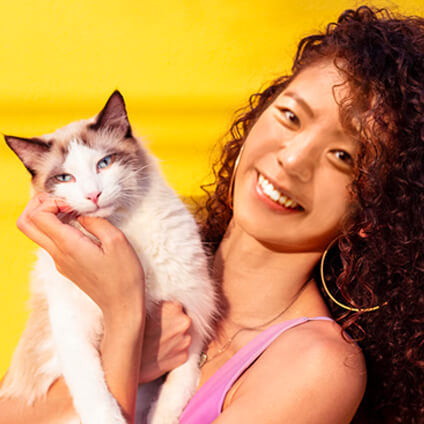
With over five years of specialized experience as an animal writer, my expertise lies in cat nutrition, health, behavior, grooming, and training. I am dedicated to delivering helpful and informative content that caters to the well-being of our feline friends. My primary goal is to empower pet owners with knowledge and ensure our feline companions thrive in health and happiness. In my free time, I love volunteering at local cat rescue centers.
